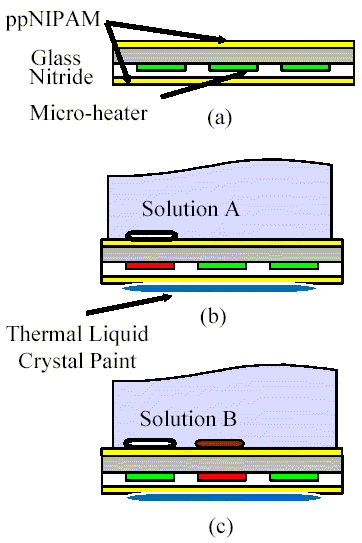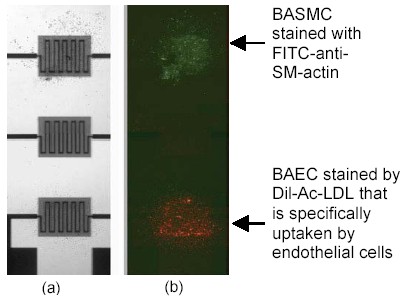Projects Archive
Thermally Responsive ppNIPAM Thin Films - Protein and Cell Arrays on Thermally Responsive Polymers
Team Members
Yanbing Wang, Yael Hanein, Ashutosh Shastry, Denice Denton, Karl F. Böhringer, Xuanhong Chen, Buddy Ratner (Bioengineering)
Summary
Programmable surface chemistry has been achieved by depositing a temperature sensitive polymer onto arrays of micro-fabricated metallic heaters. Activating a single heater causes a localized change in the device surface chemistry from non-fouling to fouling in an aqueous environment. Two types of proteins and two types of cells were used to demonstrate localized immobilization of proteins and cells on such surfaces. These experiments show, for the first time, selective cell attachments on thermally responsive polymer controlled by a micro heater array. It suggests a new approach to realize proteomic chips and cell chips.
Selected Publications
-
Xuanhong Cheng, Yanbing Wang, Yael Hanein, Karl F. Böhringer, Buddy D. Ratner, "Novel cell patterning using microheater-controlled thermoresponsive plasma films." Journal of Bio-medical Materials Research Part A, 70A(2):159-168, 1 August 2004. Won the Student Research Award in the Doctoral Degree Candidate Category, 7th Biomaterials World Congress, Sydney, Australia, May 16-21, 2004. Paper.
-
Yanbing Wang, Xuanhong Cheng, Yael Hanein, Ashutosh Shastry, Denice D. Denton, Buddy D. Ratner, Karl F. Böhringer, "Selective Attachment of Multiple Cell Types on Thermally Responsive Polymer." The 12th International Conference on Solid-State Sensors and Actuators (Transducers'03), Boston, MA, June 6-12, 2003. Paper.
-
Yanbing Wang, Xuanhong Cheng, Yael Hanein, Buddy Ratner, Karl F. Böhringer, "Protein Patterning with Programmable Surface Chemistry Chips." Sixth International Conference on Miniaturized Chemical and Biochemical Analysis Systems (Micro TAS 2002), vol.1 pp. 482-484, Nara, Japan, November 3-7, 2002. Paper. Poster.
A complete list of our publications (many of them available online) can be found here.
Acknowledgements
-
NIH National Human Genome Research Institute, Centers of Excellence in Genomic Science, Grant Number 1 P50 HG002360-01, CEGSTech: Integrated Biologically-Active Microsytems
-
National Science Foundation, SGER grant ECS-0223598.


